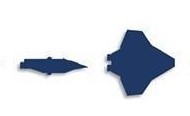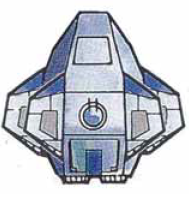Packet Ship
Packet Ship: A Packet Ship primarily carries passengers on unscheduled routes. [1]
- In that regards Packets are similar to Tramp Liners, except packets concentrate on unscheduled communications missions, while tramps concentrate on unscheduled trade missions.
- Packet Ships were once much more common across Charted Space before the rise of the X-Boat and related communications networks.
- The Supraclass designation is also known as Ship Mission, Ship Mission Code, Mission, or Ship Hull Designation.
- It is a starship supraclass.
Library Data Referral Tree[edit]
Please refer to the following AAB Library Data for more information:
Starship:
- Advanced Ship Classifications
- Ship Mission Code / Supraclass
- Ship Type Code / Superclass
- Ship Class Code / Class
- Model (TL)
- Bloc (Lot)
- Basic Ship Classifications
- Adventure Class Ship (Auxiliary Class Ship)
- Battle Class Ship (Bulk / Subcapital Class Ship)
- Capital Ship (Capital Class Ship)
- Fleet Class Ship (Capital Class Ship)
- Size-Role Classification
- Subcapital Ship (Small & Large Battle Class Ships)
- QSP
- USP
- World Class Ship
- Astronomical Unit (AU)
- FTL
- Light Speed (c)
- Light-week (lw)
- Light-year (ly)
- NAFAL (STL)
- Parsec (pc)
Description (Specifications)[edit]
Packet Ships conduct similar missions to liners and courier vessels. They are generally understood to perform unscheduled missions where postal routes do not exist. Most are equipped with mail vaults and secure staterooms. [2]
- Vessels such as Armed Packet (UF-CA33) perform unscheduled passenger service for those in a hurry. The crew can be trusted, but these little ships can still find themselves jumping into harm's way. [3]
- Generally, packet trade is any regularly scheduled cargo, passenger, and X-mail trade conducted by space or starship. The ships are sometimes called "packet boats"—in the same manner as IISS communications craft are called "x-boats"—since their original function was to carry x-mail. However, in modern times they only supplement the official system. While "packet" can mean any small parcel, its usage here most likely comes from its meaning during the pre-spaceflight Terran Age of Sail, where it meant a parcel of important correspondence—usually governmental dispatches—or valuable items for urgent delivery. [4]
General Definition[edit]
Packet ships are a class of small merchantmen generally in the 200 to 600-ton range designed to fill the gaps left by the trade lanes that follow the x-boat routes. They may be operated by planetary governments, private individuals, or corporations, they may even be assigned by a subsector duke concerned with developing the economy of their subsector. [5]
- Their purpose is to carry x-mail, passengers, and high value cargo quickly from the trade hubs to the more distant worlds within a subsector, worlds often economically unreachable with less capable jump drives. [6]
- A packet ship will typically be fully atmospheric capable, have a 2G to 3G drive for normal space operation and a Jump-3 or J-4 drive for FTL travel. [7]
- In order to qualify for mail contracts and planetary subsidies, a frontier packet ship is routinely armed and is thus designated as an armed packet. [8]
- Originally packet ships were often military surplus couriers or dispatch ships, either purchased or leased for civilian use. They have proven so useful for stimulating the frontier economy on the Imperial Fringe that purpose-built packets have all but replaced the older military designs. [9]
Image Repository[edit]
- A schematic outline of the Imperial Armed Packet featured on ship recognition playing cards used by Imperial Marines.

- A top down image of the most common Imperial Armed Packet in a common livery.

Strategy & Tactics (Doctrine)[edit]
Packet ships perform high priority missions to deliver very high value cargo or passengers to sensitive destinations. They generally focus on high value passengers who carry top secret messages in areas where the fear of electronic intercept is a concern. Packet ships usually travel at high burn to make themselves difficult to intercept. Many use jump shadows or other masking features to minimize detection. [10]
Supraclass Roles[edit]
Packet Ships typically serve the following roles:
- Armed Packet (XUA)
- Armed Packet Ship (XUA)
- Blockade Runner (XUF)
- Diplomatic Courier (XUD)
- Dispatch Boat (XUD)
- Dispatch Ship (XUD)
- Dispatch Vessel (XUD)
- Express Packet Boat (XUF)
- Fast Packet Boat (XUF)
- Fleet Dispatch Courier (XUA)
- Frontier Packet Ship (XUD)
- Long Range Fleet Courier (XUD)
- Messenger Ship (XU)
- Packet (XU)
- Packet Boat (XUB)
- Packet Carrier (XUB)
- Packet Liner (XUR)
- Packet Ship (XU) (Namesake)
- Private Courier (XUD)
- VIP Transport (XUD)
- Vargr Packet Boat (XUV)
Supraclass Archetypal Roles[edit]
These vessels typically serve the following archetypal roles:
| Selected Packet Ship Types | |||
|---|---|---|---|
| Archtype | Type Code/s | Exemplar | Remarks |
| Packet Ship | XU | ''Excalibur'' class Express Packet Boat | The generic Packet Boat is represented by a variety of types with a variety of capabilities.
|
| Armed Packet Ship | XUA | Xerxes class Armed Packet Ship | The Armed Packet Ship is designed to deal with frontier areas where hostile situations my be encountered such as a District, Rift Zone, or the Imperial Fringe.
|
| Packet Boat | XUB | No class-named example in database yet. | Packet Boat are officially system packet craft without jump drives. However, in practice, the term is used as a substitute for packet ships. So, many such Boats have jump drives despite the contradiction of terms. Such vessels can be smallcraft or bigcraft. They are system communicators in which a jump courier isn't warranted such as for extended mining or science operations in the Remote System, Far System, Oort Clouds, Kuiper Belt, Hill Sphere, or the like. Such operations save considerable amounts by not needing to invest in jump drives for scheduled, routine communications service.
|
| Dispatch Ship | XUD | Chercheur class Fleet Dispatch Courier | Dispatch Ships focus on even smaller loads and fewer passengers than the typical packet ship. Dispatch ships often focus on VIP transport and sensitive high value cargos.
|
| Fast Packet Boat | XUF | Excalibur class Express Packet Boat | Express Packet Boats use more capable jump drives, often in the J:5-6 range. But, not always. Some express boats are named as such, but use regular frames and drives. These boats, especially the higher G models are known to be used as light, nimble blockade runners.
|
| Packet Liner | XUR | No class-named example in database yet. | Packet Liner are much larger ships able to handle more VIP passengers. Packet liners are known to be used as heavy blockade runners.
|
| Vargr Packet Boat | XUV | ''Dhaztuen'' class Packet Ship | The Vargr Extents is far more chaotic and dangerous than Imperial Space. Larger, better armed and armored hulls tend to be the norm in use by Vargrs.
|
History & Background (Dossier)[edit]
A number of types of communication vessels exist, and the packet ship has come to occupy a ship mission niche not occupied by x-boats, courier vessels, relay vessels, or other kinds of ships that perform communication duties. Packet ships were once far more numerous before the establishment of the X-boat System in the year 624. [11]
They remain in use as of 1105, but are much less prevalent today. Some packet ships such as the Vargr ''Dhaztuen'' class Packet Ship or ''Dhaztuen'' class Far Merchant are also double-missioned in the same manner as Scout/Couriers. [12]
Selected Variant Types & Classes[edit]
Civilian ship - Communication Vessel - Packet Ship:
Civilian ship - Communication Vessel - Packet Ship:
Civilian ship - Communication Vessel - Packet Ship:
- Type XUB class Packet Boat
- No exemplar yet available.
Civilian ship - Communication Vessel - Packet Ship:
Civilian ship - Communication Vessel - Packet Ship:
Civilian ship - Communication Vessel - Packet Ship:
- Type XUR class Packet Liner
- No exemplar yet available.
Civilian ship - Communication Vessel - Vargr Packet Ship:
Ship Summary List[edit]
Some of the most commonly used vessels in this role include:
| 1 Representative Packet Ship (XU) Classes | |||||||||||||||||||||||||||
|---|---|---|---|---|---|---|---|---|---|---|---|---|---|---|---|---|---|---|---|---|---|---|---|---|---|---|---|
|
| 1 Representative Armed Packet Ship (XUA) Classes | |||||||||||||||||||||||||||
|---|---|---|---|---|---|---|---|---|---|---|---|---|---|---|---|---|---|---|---|---|---|---|---|---|---|---|---|
|
| 0 Representative Packet Boat (XUB) Classes | |
|---|---|
| No results |
| 0 Representative Dispatch Ship (XUD) Classes | |
|---|---|
| No results |
| 0 Representative Fast Packet Boat (XUF) Classes | |
|---|---|
| No results |
| 0 Representative Packet Liner (XUR) Classes | |
|---|---|
| No results |
| 0 Representative Vargr Packet Boat (XUV) Classes | |
|---|---|
| No results |
References & Contributors (Sources)[edit]
| This page uses content from Wikipedia. The original article was at Packet_boat. The list of authors can be seen in the page history. The text of Wikipedia is available under the Commons Attribution-ShareAlike 3.0 Unported License. |
| This page uses content from Wikipedia. The original article was at Packet_trade. The list of authors can be seen in the page history. The text of Wikipedia is available under the Commons Attribution-ShareAlike 3.0 Unported License. |
- Bob McWilliams. IISS Ship Files (Games Workshop, 1981), TBD.
- Frank Chadwick, John Harshman, J. Andrew Keith, Marc Miller, Loren Wiseman. The Traveller Adventure (Game Designers Workshop, 1983), 152.
- J. Andrew Keith, Marc Miller, John Harshman. Vargr (Game Designers Workshop, 1984), 13.
- Simon Beal. Vargr (Mongoose Publishing, 2009), TBD.
- Marc Miller. T5 Core Rules (Far Future Enterprises, 2013), TBD.
- Tom Mouat, Ian Stead. Traveller Ship Font (Moon Toad Publishing, 2019), TBD.
- Traveller Wiki Editorial Team
- Author & Contributor: Randy Dorman
- Author & Contributor: Robert Eaglestone
- Author & Contributor: Mike Wightman
- Author & Contributor: Lord (Marquis) and Master of Sophontology Maksim-Smelchak of the Ministry of Science
- ↑ Marc Miller. T5 Core Rules (Far Future Enterprises, 2013), 65.
- ↑ Information provided to the library by Maksim-Smelchak
- ↑ Marc Miller. T5 Core Rules (Far Future Enterprises, 2013), 738.
- ↑ Information provided to the library by Maksim-Smelchak
- ↑ Information provided to the library by Mike Wightman
- ↑ Information provided to the library by Mike Wightman
- ↑ Information provided to the library by Mike Wightman
- ↑ Information provided to the library by Mike Wightman
- ↑ Information provided to the library by Mike Wightman
- ↑ Information provided to the library by Maksim-Smelchak
- ↑ Information provided to the library by Maksim-Smelchak
- ↑ Information provided to the library by Maksim-Smelchak